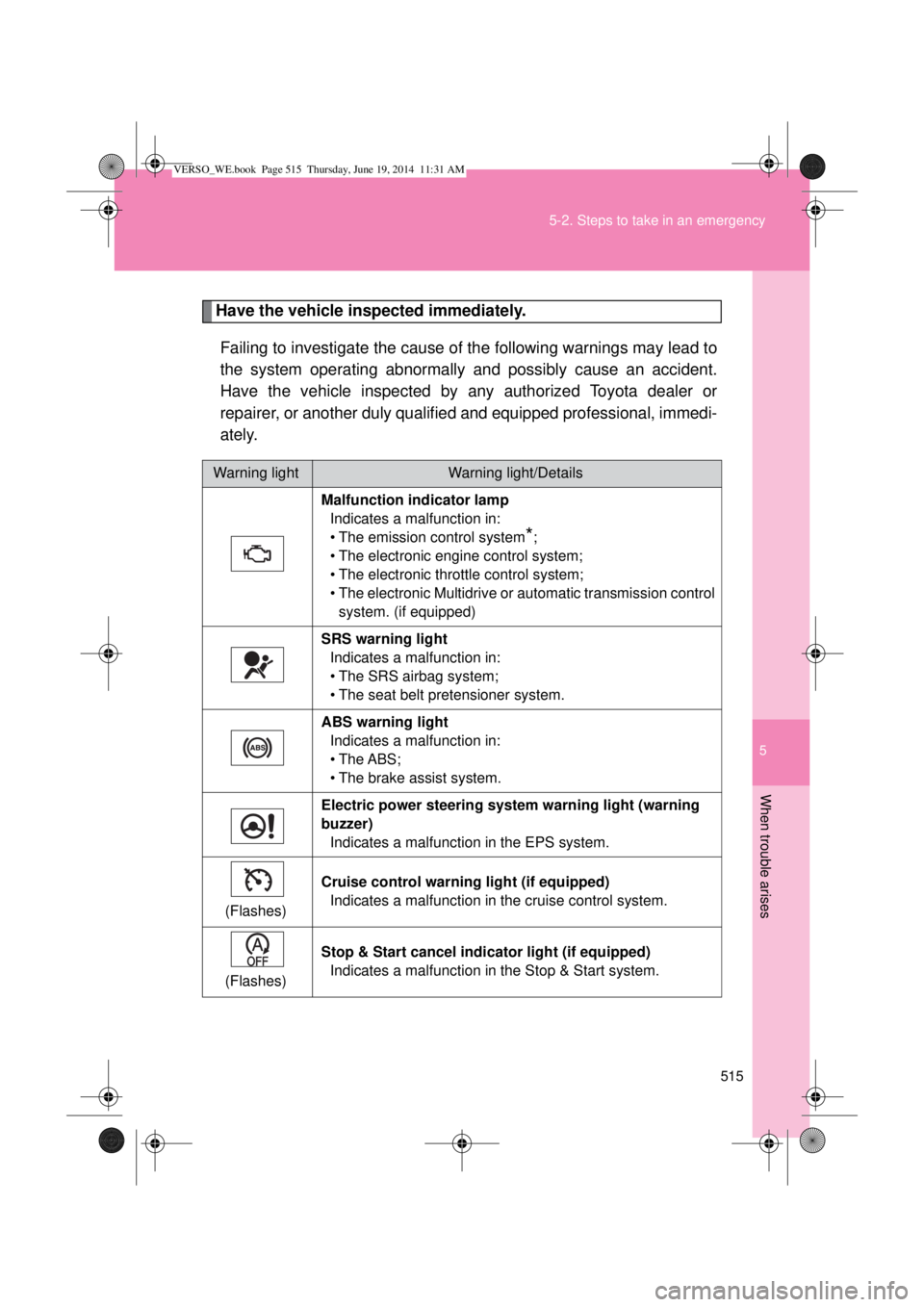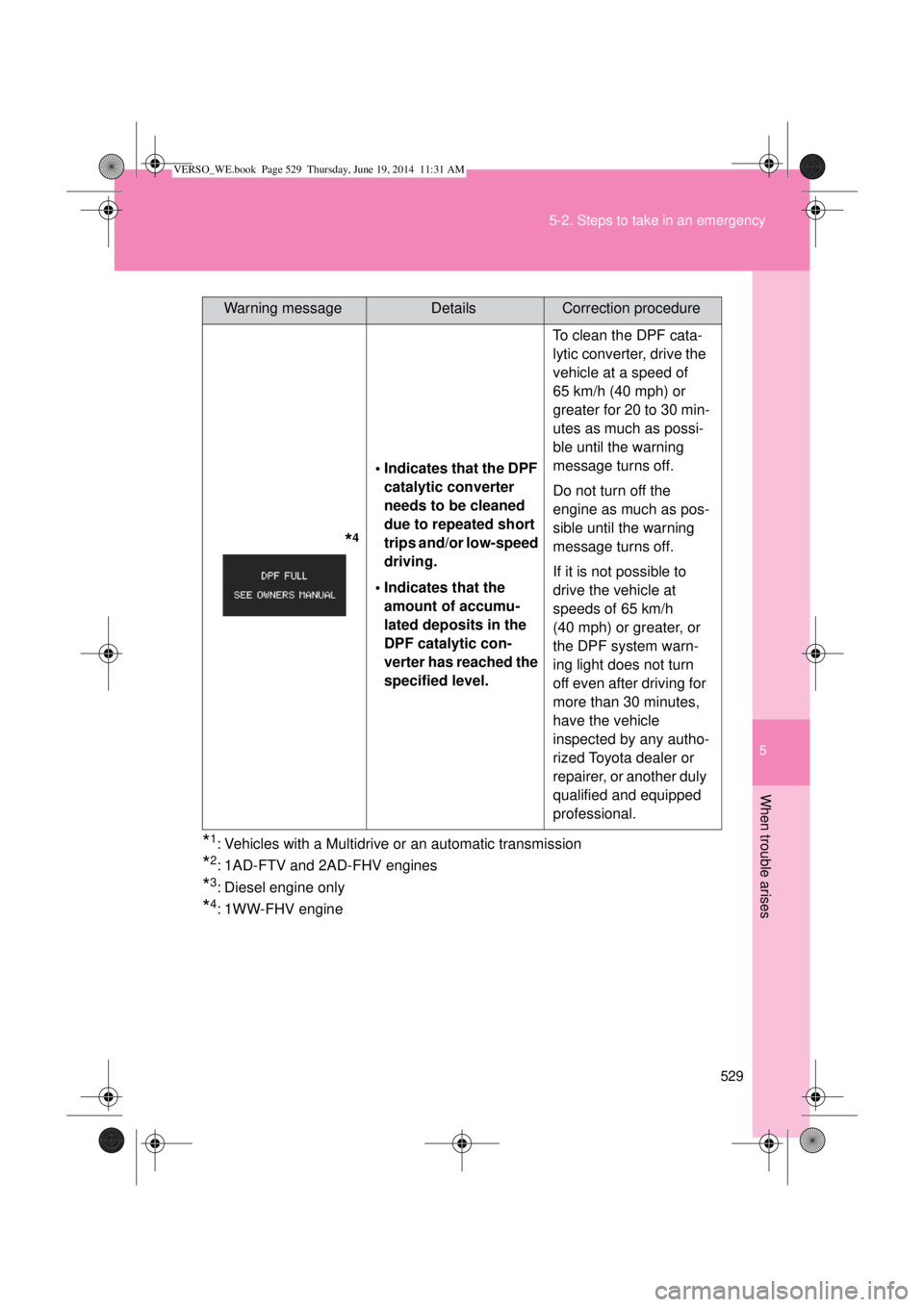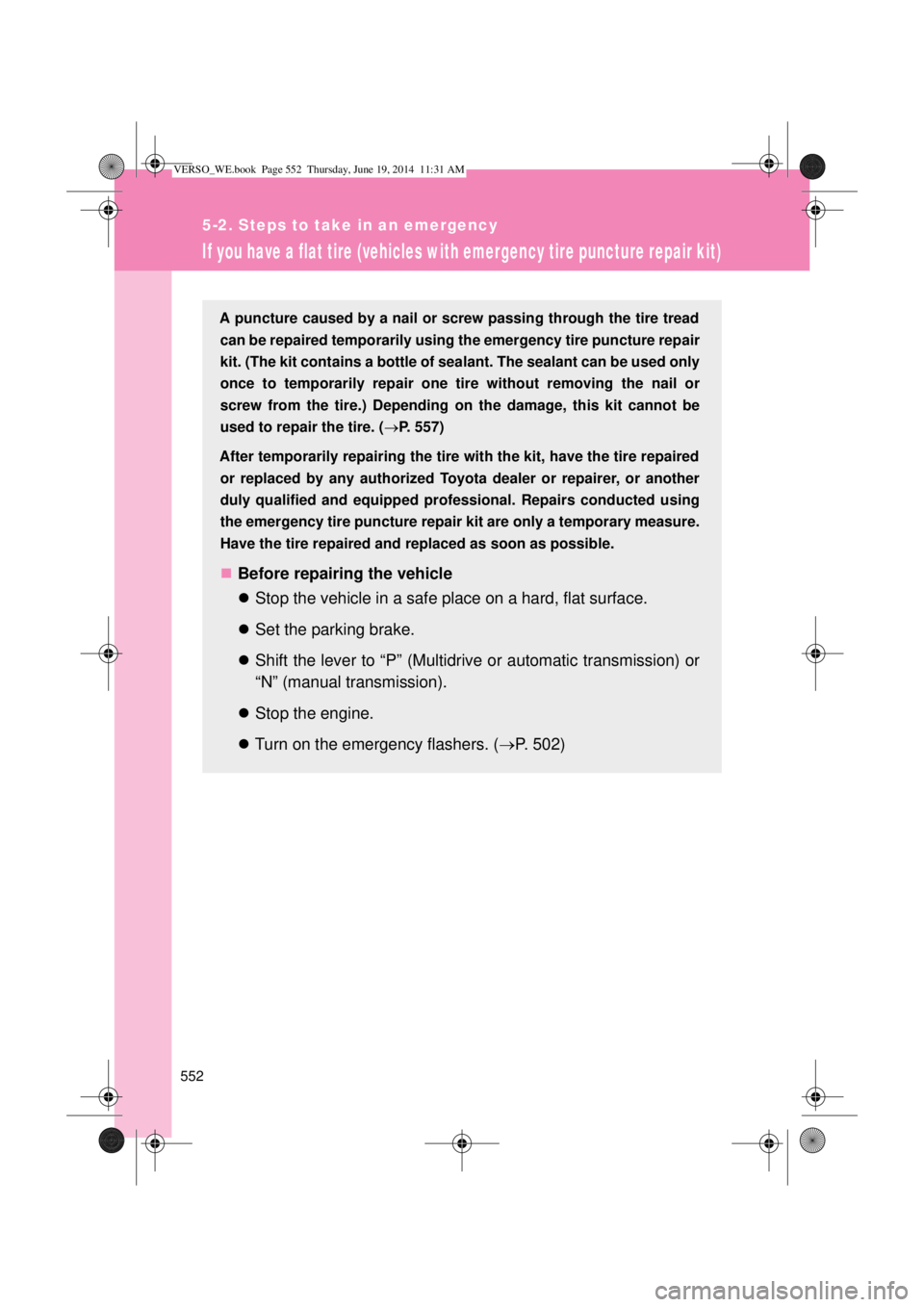Page 509 of 650
5
509 5-1. Essential information
When trouble arises
Towing with a wheel-lift type truck from the rear
Vehicles with a Multidrive or an
automatic transmission: Use a
towing dolly under the front
wheels.
Vehicles with a manual transmis-
sion: We recommend to use a
towing dolly under the front
wheels.
Vehicles without smart entry &
start system: When not using a
towing dolly, turn the engine
switch to the “ACC” position and
shift the shift lever to “N”.
Vehicles with smart entry & start
system: When not using a towing
dolly, turn the “ENGINE START
STOP” switch to ACCESSORY
mode and shift the shift lever to
“N”.
VERSO_WE.book Page 509 Thursday, June 19, 2014 11:31 AM
Page 510 of 650

510 5-1. Essential information
NOTICE
To prevent causing serious damage to the transmission
(vehicles with a Multidrive or an automatic transmission)
Never tow this vehicle from the rear with the front wheels on the ground.
When towing a vehicle without using a towing dolly (vehicles with a
manual transmission)
Vehicles without smart entry & start system: The engine switch must not
be in the “LOCK” position.
The steering lock mechanism is not strong enough to hold the front wheels
straight.
Vehicles with smart entry & start system: The “ENGINE START STOP”
switch must not be off.
The steering lock mechanism is not strong enough to hold the front wheels
straight.
To prevent damaging the vehicle (vehicles with a manual transmission)
Vehicles without smart entry & start system: Do not tow the vehicle from
the rear when the engine switch is in the “LOCK” position or the key is
removed. The steering lock mechanism is not strong enough to hold the
front wheels straight.
Vehicles with smart entry & start system: Do not tow the vehicle from the
rear with the “ENGINE START STOP” switch off. The steering lock mecha-
nism is not strong enough to hold the front wheels straight.
When raising the vehicle, ensure adequate ground clearance for towing at
the opposite end of the raised vehicle. Without adequate clearance, the
vehicle could be damaged while being towed.
VERSO_WE.book Page 510 Thursday, June 19, 2014 11:31 AM
Page 515 of 650

5
515 5-2. Steps to take in an emergency
When trouble arises
Have the vehicle inspected immediately.
Failing to investigate the cause of the following warnings may lead to
the system operating abnormally and possibly cause an accident.
Have the vehicle inspected by any authorized Toyota dealer or
repairer, or another duly qualified and equipped professional, immedi-
ately.
Warning lightWarning light/Details
Malfunction indicator lamp
Indicates a malfunction in:
• The emission control system
*;
• The electronic engine control system;
• The electronic throttle control system;
• The electronic Multidrive or automatic transmission control
system. (if equipped)
SRS warning light
Indicates a malfunction in:
• The SRS airbag system;
• The seat belt pretensioner system.
ABS warning light
Indicates a malfunction in:
• The ABS;
• The brake assist system.
Electric power steering system warning light (warning
buzzer)
Indicates a malfunction in the EPS system.
(Flashes)Cruise control warning light (if equipped)
Indicates a malfunction in the cruise control system.
(Flashes)Stop & Start cancel indicator light (if equipped)
Indicates a malfunction in the Stop & Start system.
VERSO_WE.book Page 515 Thursday, June 19, 2014 11:31 AM
Page 527 of 650
5
527 5-2. Steps to take in an emergency
When trouble arises
(Flashes)Indicates that the
parking brake is still
engaged.
A buzzer sounds to
indicate that parking
brake is still engaged
(with the vehicle hav-
ing reached a speed
of more than 5 km/h [3
mph]).Release the parking
brake.
*1Indicates that the Mul-
tidrive or automatic
transmission fluid
temperature is too
high.
A buzzer also sounds.Stop the vehicle in a
safe place and shift
lever to “P”.
If the light does not go
off, contact any autho-
rized Toyota dealer or
repairer, or another duly
qualified and equipped
professional.
*2
Indicates that engine
oil level is low.
A buzzer also sounds.Check the level of
engine oil, and add if
necessary.
(Flashes)Indicates that the
headlight switch is left
on (with the key
removed and the
driver’s door opened).
A buzzer also sounds.Turn the headlight
switch off.
Warning messageDetailsCorrection procedure
VERSO_WE.book Page 527 Thursday, June 19, 2014 11:31 AM
Page 529 of 650

5
529 5-2. Steps to take in an emergency
When trouble arises
*1: Vehicles with a Multidrive or an automatic transmission
*2: 1AD-FTV and 2AD-FHV engines
*3: Diesel engine only
*4: 1WW-FHV engine
*4
• Indicates that the DPF
catalytic converter
needs to be cleaned
due to repeated short
trips and/or low-speed
driving.
• Indicates that the
amount of accumu-
lated deposits in the
DPF catalytic con-
verter has reached the
specified level.To clean the DPF cata-
lytic converter, drive the
vehicle at a speed of
65 km/h (40 mph) or
greater for 20 to 30 min-
utes as much as possi-
ble until the warning
message turns off.
Do not turn off the
engine as much as pos-
sible until the warning
message turns off.
If it is not possible to
drive the vehicle at
speeds of 65 km/h
(40 mph) or greater, or
the DPF system warn-
ing light does not turn
off even after driving for
more than 30 minutes,
have the vehicle
inspected by any autho-
rized Toyota dealer or
repairer, or another duly
qualified and equipped
professional.
Warning messageDetailsCorrection procedure
VERSO_WE.book Page 529 Thursday, June 19, 2014 11:31 AM
Page 535 of 650
5
535 5-2. Steps to take in an emergency
When trouble arises
*1: Vehicles with a Multidrive or an automatic transmission
*2: Vehicles with a manual transmission
Once
(Flashes)
(Green
indicator
flashes)Indicates that
the steering
lock has not
released within
3 seconds of
pressing the
“ENGINE
START STOP”
switch.Press the
“ENGINE
START STOP”
switch again
while turning
the steering
wheel with the
brake pedal
depressed.
Interior
buzzerExterior
buzzerWarning messageDetailsCorrection
procedure
VERSO_WE.book Page 535 Thursday, June 19, 2014 11:31 AM
Page 536 of 650
536
5-2. Steps to take in an emergency
If you have a flat tire (vehicles with spare tire)
Remove the flat tire and replace it with the spare provided.
Before jacking up the vehicle
Stop the vehicle on a hard, flat surface.
Set the parking brake.
Shift the shift lever to “P” (Multidrive or automatic transmis-
sion) or “R” (manual transmission).
Stop the engine.
Turn on the emergency flashers. (P. 502)
Location of the spare tire, jack and tools
Vehicles without the third seat
Spare tire
Jack
handleJack
Wheel nut wrench
Towing eyelet
VERSO_WE.book Page 536 Thursday, June 19, 2014 11:31 AM
Page 552 of 650

552
5-2. Steps to take in an emergency
If you have a flat tire (vehicles with emergency tire puncture repair kit)
A puncture caused by a nail or screw passing through the tire tread
can be repaired temporarily using the emergency tire puncture repair
kit. (The kit contains a bottle of sealant. The sealant can be used only
once to temporarily repair one tire without removing the nail or
screw from the tire.) Depending on the damage, this kit cannot be
used to repair the tire. (P. 557)
After temporarily repairing the tire with the kit, have the tire repaired
or replaced by any authorized Toyota dealer or repairer, or another
duly qualified and equipped professional. Repairs conducted using
the emergency tire puncture repair kit are only a temporary measure.
Have the tire repaired and replaced as soon as possible.
Before repairing the vehicle
Stop the vehicle in a safe place on a hard, flat surface.
Set the parking brake.
Shift the lever to “P” (Multidrive or automatic transmission) or
“N” (manual transmission).
Stop the engine.
Turn on the emergency flashers. (P. 502)
VERSO_WE.book Page 552 Thursday, June 19, 2014 11:31 AM